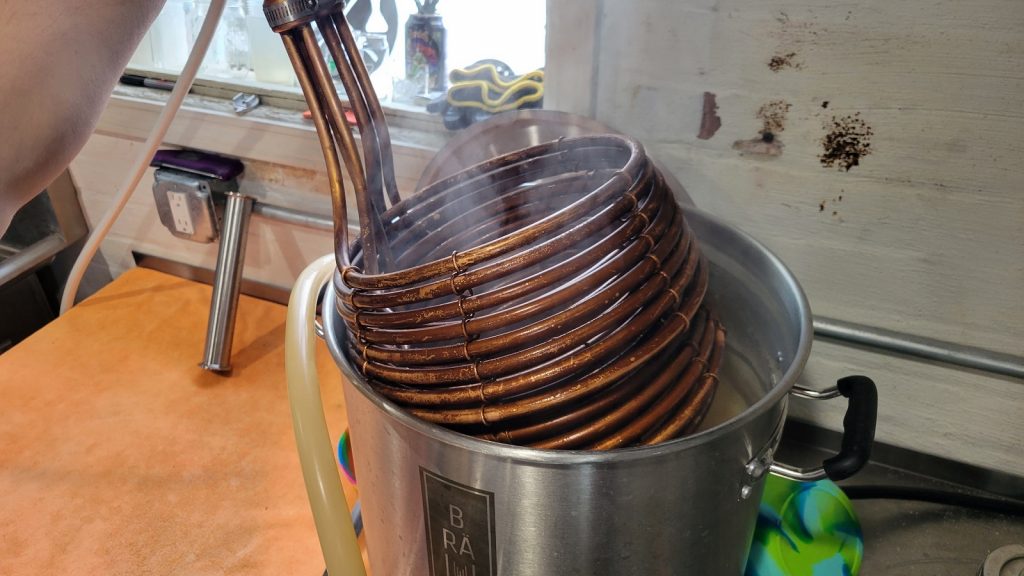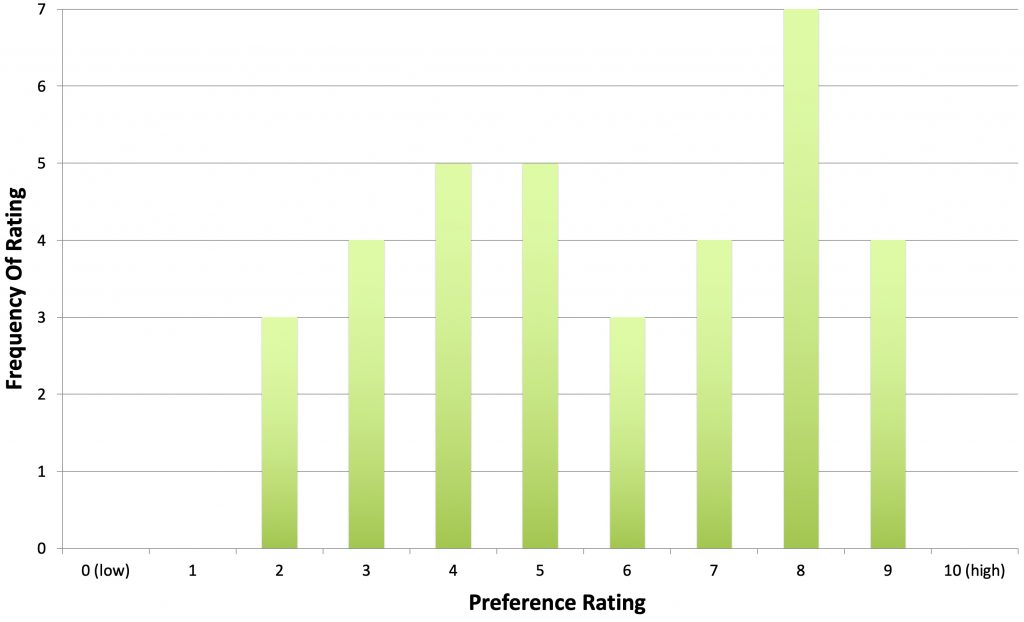Author: Mike Neville
While hops have been grown in South Africa since at least the 1920s, they only recently seem to have come to the attention of most brewers, and one variety that has gained popularity is Southern Star. Selected from a cross of the mother Outeniqua and father OF2/93, Southern Star’s higher alpha acid level makes it a solid bittering hop, though it’s also known to impart strong pineapple, tangerine, and tropical fruit characteristics when used later in the brewing process.
Alpha: 12 – 18%
Beta: 4 – 6%
Cohumulone: 25 – 30% of alpha acids
Total Oil: 1.4 – 1.7 mL/100g
Myrcene: 27.5 – 38.9%
Humulene: 21.9 – 32.8%
Caryophyllene: 11.2 – 14.6%
Farnesene: 4.5 – 12%
Linalool: < 1%
Geraniol: unknown
ß-Pinene: unknown
Parentage: diploid seedling selected from a cross of Outeniqua and OF2/93
I’d never brewed with South African hops, but had heard good things over the last few years and was curious to learn more about this variety. After picking some up, I decided to use it on its own in a single-hop Pale Ale that I’d serve to blind tasters for evaluation.
| MAKING THE BEER |
I went with our standard Hop Chronicles Pale Ale recipe for this batch, making minor adjustments to the kettle hop additions to ensure the bitterness was in check.
Southern Star Pale Ale
Recipe Details
| Batch Size | Boil Time | IBU | SRM | Est. OG | Est. FG | ABV |
|---|---|---|---|---|---|---|
| 5.5 gal | 60 min | 41.5 | 3.9 SRM | 1.056 | 1.007 | 6.43 % |
| Actuals | 1.056 | 1.007 | 6.43 % | |||
Fermentables
| Name | Amount | % |
|---|---|---|
| Pale 2-Row Malt | 10 lbs | 83.33 |
| Vienna Malt | 2 lbs | 16.67 |
Hops
| Name | Amount | Time | Use | Form | Alpha % |
|---|---|---|---|---|---|
| Southern Star | 7 g | 30 min | Boil | Pellet | 13.3 |
| Southern Star | 14 g | 15 min | Boil | Pellet | 13.3 |
| Southern Star | 28 g | 10 min | Boil | Pellet | 13.3 |
| Southern Star | 57 g | 2 min | Boil | Pellet | 13.3 |
| Southern Star | 57 g | 4 days | Dry Hop | Pellet | 13.3 |
Yeast
| Name | Lab | Attenuation | Temperature |
|---|---|---|---|
| Flagship (A07) | Imperial Yeast | 77% | 32°F - 32°F |
Notes
| Water Profile: Ca 125 | Mg 20 | Na 8 | SO4 310 | Cl 56 |
Download
| Download this recipe's BeerXML file |
I started off my brew day by flipping the switch on my controller to heat up the water I’d previously adjusted to my desired profile before weighing out and milling the grain.
When the water was properly heated, I incorporated the grains and set the controller to maintain my desired mash temperature.
While waiting on the mash, I prepared the kettle hop additions.
Once the 60 minute mash rest was complete, I removed the grains and proceeded to boil for 60 minutes, adding hops at the times stated in the recipe.
When the boil was complete, I used my Hydra IC to quickly chill the wort.
Next, I transferred the chilled wort to a sanitizer fermenter.
A refractometer reading showed the wort was at my target OG.

I then direct pitched a single pouch of Imperial Yeast A07 Flagship into the wort.
The beer was left to ferment at 66°F/19°C for 8 days before I took a hydrometer measurement confirming FG was reached.

With fermentation complete, I pressure transferred the beer to a CO2 purged keg that was placed in my keezer and burst carbonated overnight before I reduced the gas to serving pressure. After a week of conditioning, I began serving it to blind tasters.
| METHOD |
Participants were instructed to focus only on the aromatic qualities of the beer before evaluating the flavor. For each aroma and flavor descriptor, tasters were asked to write-in the perceived strength of that particular characteristic on a 0-9 scale where a rating of 0 meant they did not perceive the character at all and a 9 rating meant the character was extremely strong. Once the data was collected, the average rating of each aroma and flavor descriptor was compiled and analyzed.
| RESULTS |
A total of 35 people participated in the evaluation of this beer, all blind to the hop variety used until after they completed the survey. The average aroma and flavor ratings for each descriptor were plotted on a radar graph.
Average Ratings of Aroma and Flavor Perceptions
The 3 characteristics endorsed as being most prominent by participants:
| Aroma | Flavor |
| Citrus | Citrus |
| Tropical Fruit | Tropical Fruit |
| Stone Fruit | Melon |
The 3 characteristics endorsed as being least prominent by participants:
| Aroma | Flavor |
| Onion/Garlic | Onion/Garlic |
| Spicy/Herbal | Berry |
| Grassy | Dank/Catty |
Next, participants were asked to rate the pungency/strength of the hop.
Tasters were then instructed to identify beer styles they thought the hop would work well in.
Finally, participants were asked to rate how much they enjoyed the hop character on a 1 to 10 scale.
My Impressions: Most prominently, I perceived a pleasant combination of orange, tangerine, and floral character in this beer, though I picked up hints of melon as it warmed in the glass. While noticeable, I felt the overall hop intensity was a bit restrained.
| CONCLUSION |
Up until fairly recently, it was widely believed that a select few regions were capable of producing high quality hops, namely the Yakima Valley of Washington, the Willamette Valley of Oregon, and the Hallertau region of Germany. However, this perspective has shifted of late with the introduction of new hops from various regions including South Africa, where the Southern Star variety is from.
The most prominent aroma and flavor characteristics noted by people who evaluated a Pale Ale made solely with Southern Star were citrus, tropical fruit, and stone fruit, while onion/garlic, spicy/herbal, and berry were the least endorsed characteristics. With a strong majority of tasters rating the pungency of this hop as being moderate to strong, it’s understandable why so many felt it would work well in hoppy styles such as IPA and Pale Ale.
Having never used a South African variety, I was excited to brew with Southern Star and ended up enjoying the characteristics it imparted to this Pale Ale. Based on both the blind taster ratings as well as my personal experience, I look forward to using this hop in combination with other varieties in future batches of IPA to get a more layered fruit profile.
Southern Star hops are available at Yakima Valley Hops, get some when they’re available! If you have any thoughts on this variety, please feel free to share them in the comments section below.
Support Brülosophy In Style!
All designs are available in various colors and sizes on Amazon!
Follow Brülosophy on:
FACEBOOK | TWITTER | INSTAGRAM
If you enjoy this stuff and feel compelled to support Brulosophy.com, please check out the Support page for details on how you can very easily do so. Thanks!



























4 thoughts on “The Hop Chronicles | Southern Star (2019) Pale Ale”
Hi Mike, was this the sample that was shared at the recent home brewers meet up at Cadillac Straights?
If not, disregard my pointless ramble.
If so, I was reading up on it after having tasted and was surprised at the differences in my perception and the suggested notes to expect. I did not get as much of the citrus or fruity and got more of the pine/spice/resinous. Was super cool to have become a statistic in the Chronicles of Hops that I so often read and rely on when choosing my hops.
Hey Matt – Yeah, last months meetup! I tend to agree with you on this one. While I did get a good amount of orangey citrus, I was a little surprise to see tasters didn’t rate floral or, as you said, spice/pine a little higher. Thanks for taking part! I wanted to get to the meetup this past Monday, but that snow deterred me. I’m not going to make the May meetup, but hope to be back for in June with more data to collect.
Cool! Well it was nice to meet you and try the beer.
Now that you say it, floral was more of what I got. I think I noted that this hop could be good for an American Pils.
I didn’t make the last meet up either. Not sure if I’ll be back until the fall, with a baby due in July.
Look forward to offering my taste buds to your cause.
I enjoy these writeups a lot and I think it’s great to get a cumulative record of the stats recorded.
If I can offer a recommendation, it would be great to get more subjective reactions on top of the stats — for instance, more descriptions of what kind of citrus, comparisons to other hops, etc. I realize the subjective points of view are, well, subjective, but I think they’re still interesting and helpful to round out the data.
Thanks for the good work.